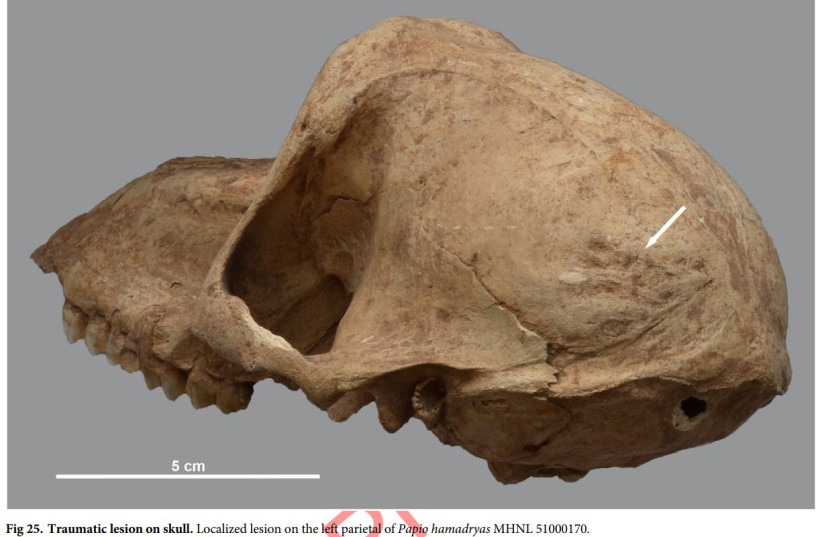Baboons were raised in captivity and then, after they died, were mummified in ancient Egypt, according to a study just published on 41 pages by Belgian scientists in the open-access journal PLOS ONE.
Entitled “Palaeopathological and demographic data reveal conditions of keeping of the ancient baboons at Gabbanat el-Qurud (Thebes, Egypt),” it was written by Wim Van Neer of the Royal Belgian Institute of Natural Sciences and colleagues who examined skeletal remains representing at least 36 individual baboons of varying ages, dated to between 800 to 500 BCE.
They found lesions, deformations, and other abnormalities on the bones that indicated that most of the primates suffered from poor nutrition and a lack of sunlight – most likely as a result of being born and raised in captivity. The authors note that similar conditions are seen in baboon remains from two other sites of similar age, Saqqara and Tuna el-Gebel, suggesting a fairly consistent mode of captive keeping in all three sites.
Ancient Egyptian baboon
For over a millennium, from the 9th Century BCE to the 4th Century CE, ancient Egyptians venerated and mummified various animal species for religious purposes. Included among these animals were baboons (Papio hamadryas and Papio anubis) – notably species that were not native to ancient Egypt, so little is known about how these energetic, intelligent, but violent creatures were acquired and kept. In this study, the researchers examined a collection of baboon mummies from the ancient Egyptian site of Gabbanat el-Qurud, the so-called Valley of the Monkeys on the west bank of Luxor.
There are five species of baboons, all of them live in Africa or Arabia. They are among the world's largest monkeys, and males of different species average from 13 to 37 kilos. They usually prefer semi-arid habitats, but a few live in tropical forests. They live in violent environments with males fighting over food including roots, seeds and bark; females; and places to rest. They eat roots, fruit, grubs and other insects. Baboons are largely ground-dwelling animals who have a varied diet that includes fruit, roots, and grubs and other insects and live for two or three decades, but some survive for up to 40 years.

Females typically give birth every other year, usually to a single baby after a sixth-month pregnancy. Baboons ae petrified when they see a snake and dangerous when threatened or provoked –but they only rarely attack humans. All baboons have long, dog-like muzzles, heavy, powerful jaws with sharp canine teeth, close-set eyes, thick fur except on their muzzles, short tails, and nerveless, hairless pads of skin on their protruding buttocks that make sitting comfortable. They usually sleep on trees, rocks or cliffs at night to escape predators while snoozing.
The team examined skeletal remains representing at least 36 baboons of varying ages, dated to between 800-500 BCE. Lesions, deformations, and other abnormalities on the bones indicate that most of the baboons suffered from poor nutrition and a lack of sunlight, most likely as a result of being born and raised in captivity. The authors note that similar conditions are seen in baboon remains from two other sites of similar age, Saqqara and Tuna el-Gebel, suggesting a fairly consistent mode of captive-keeping in all three sites.
The archaeologists were especially interested in the presence of four apparently healthy baboons lacking clear traces of metabolic disease or trauma. The only medical problems they had were cavities in some of their teeth.
For more than a millennium, tens of millions of mummies of a variety of animals – including dogs, cats, ibises, and birds of prey – have been discovered in necropolises across the country, testifying to the Egyptians’ attention to creatures they regarded as sacred that were dear to the gods, the authors wrote. Selected individuals, a minority, were considered incarnations of deities among humans, for example bulls or crocodiles. These chosen ones, of whom there could be no more than one at a time, were mummified and buried in a more elaborate way in necropolises constructed specifically for this purpose. These sacred animals were accompanied by grave goods that resembled the inventories given to humans.
The Belgian authors suggested that further examination of the animals’ teeth could provide more data on the diets they were fed, and if it is possible to extract DNA from these remains, genetic data might reveal information on where the animals were caught in the wild and what breeding practices their keepers were employing. They added that “Life was not easy for Egypt’s sacred baboons.”
